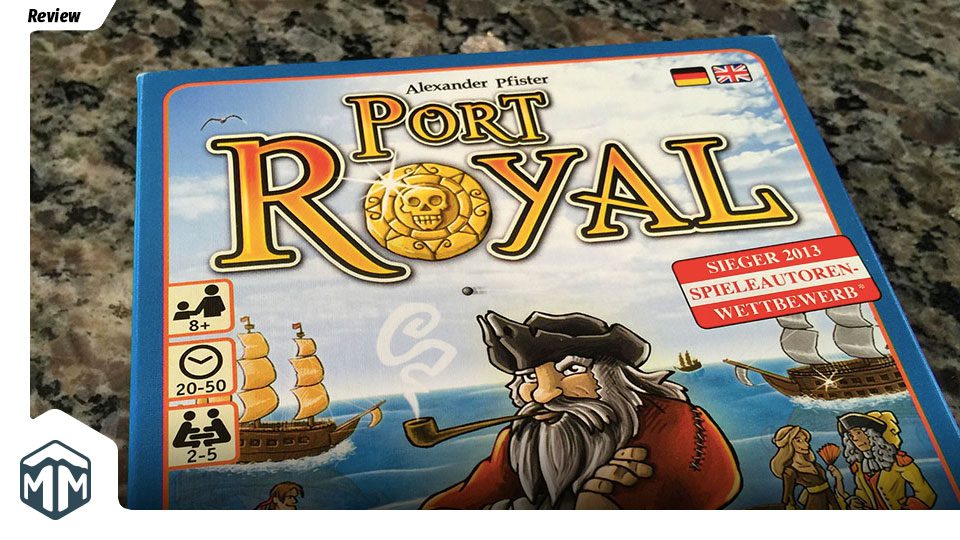Port Royal Overview
In this press your luck style set collection card game from Alexander Pfister, players act as merchants in the Caribbean city of Port Royal: gaining wealth, fending off pirates, and growing their influence in the dockyards. Port Royal is an excellent game with clever gameplay and multi-use cards. Win the game with 12 victory points but be careful not to get too greedy though or you’ll wind up with nothing.
Set sail for Port Royal!
How to Set Up Port Royal

5 player expedition card
To set up a game of Port Royal shuffle the entire deck and deal 3 cards to each player with coin side face up (these cards will be used as money). For a 5 player game remove the expedition card showing 5 hats on the back and place it to the side. Place the remaining deck of cards in the center of the table and select a start player. You’re now ready to play Port Royal!
How to Play Port Royal
Each player’s turn in Port Royal is split into two phases:
- Discover – in which the current player will draw cards from the top of the deck and place them nearby in an area known as the Harbor; the central tableau for the game.
- Trade & Hire – in which all players purchase cards from the Harbor and place them in their own personal area.
Before we get too deep into the explanation of turns, let’s take a minute to get familiar with the deck.
The Cards of Port Royal
Port Royal comes with a deck of 120 double sided cards. The back of every card (except for the 5 player expedition card) displays a gold coin which players will use as money.
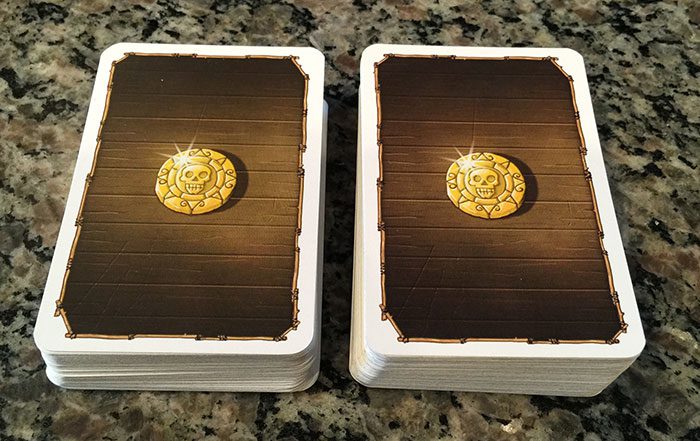
The front of every card will show one of 4 different types of cards.
Ships
Ship cards are a player’s primary source of income and come in 5 different colors, income values (the number of coins at the top), and varying strength (the number of swords at the bottom). The number of coins at the top of the card is how many coins you’ll draw from the deck if you select that ship.

When drawing cards from the deck, if you draw a ship with a color already represented in the Harbor then your turn is immediately over unless you have a number of swords equal to, or greater than, the number at the bottom of the ship.
Persons
The person cards display various people who live and work around the harbor: sailors, admirals, priests, traders, and “mademoiselles”. These cards are available to be hired by players, and when hired will be placed in front of you for the remainder of the game (except in a few cases).
Each person card has 3 points of interest. The Cost is how much it will cost to hire this person. The Points are how much this person will be worth in victory points at the end of the game. The Benefit is what players will receive for keeping this card in front of them. In the example below the Trader costs 5 coins, is worth 2 victory points, and provides an additional coin when taking a blue ship from the Harbor display.
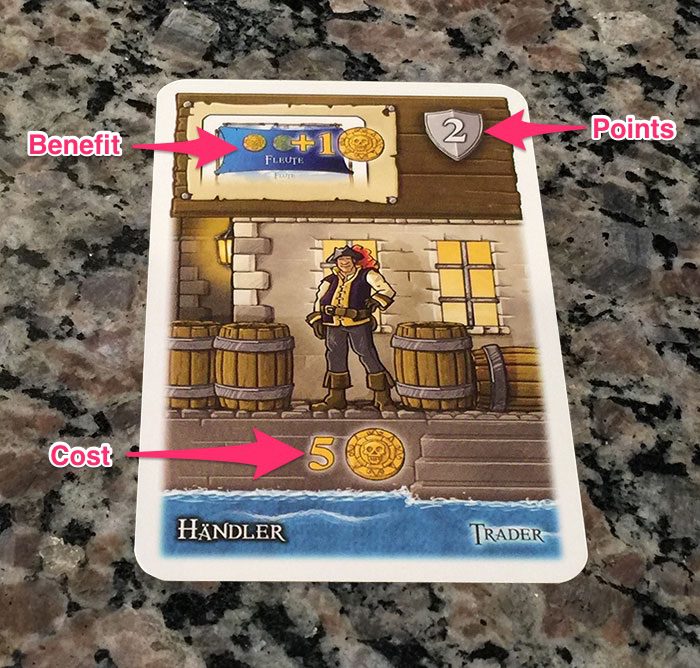
There are Traders for each of the 5 differently colored ships in the game. Collecting Traders is an excellent way to build up an economic engine in the game.
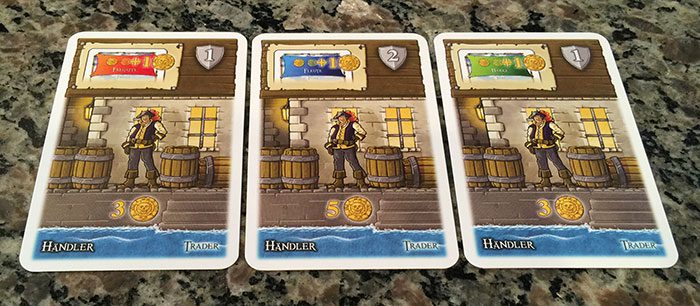
Some of the persons you hire might have swords, an anchor, a cross, or a cabin. Cards with swords can be used to repel various ships coming into Harbor, while cards with anchors, crosses, or cabins can be traded for valuable expedition cards worth more points.
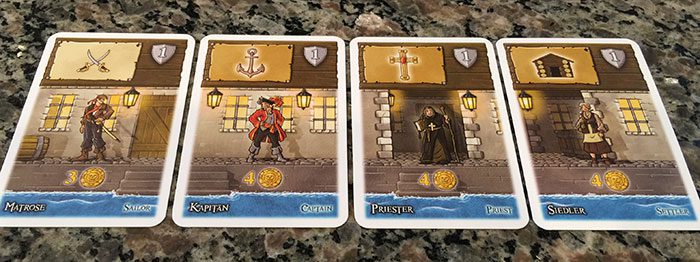
Finally the remaining person cards provide benefits on a player’s turn. The Governor is worth 0 victory points, and costs 8 coins, but allows the player to select an additional card on their turn. The Admiral card gives players an immediate 2 coins any time there are 5 or more cards in the Harbor when it is their turn to choose a card. Finally, the Jester card gives players an immediate coin if there are NO cards in the Harbor when it is their turn to choose a card.
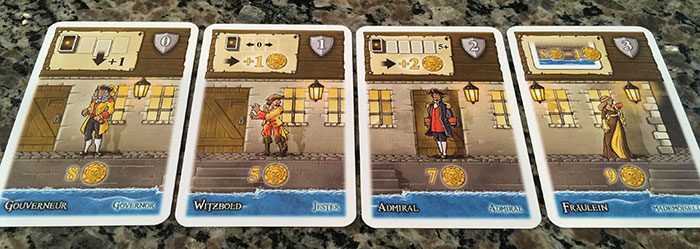
Expeditions
Expedition cards offer players another path to victory, allowing them to collect sets of person cards which feature anchors, crosses, or cabins.
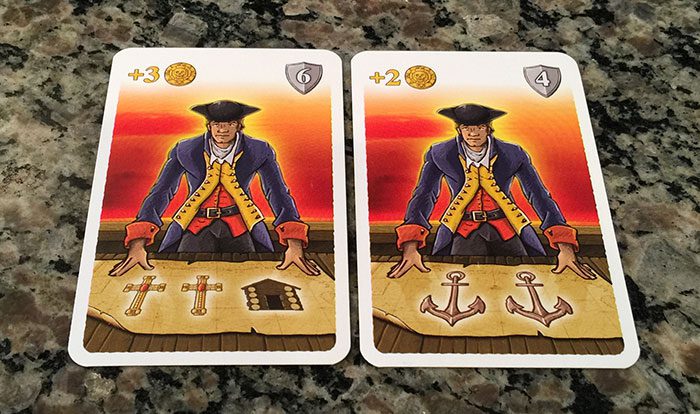
When expedition cards are drawn, they’re immediately placed to the side in view of all players. When a player hires a person who allows them to fulfill an expedition card, they discard the person cards and place the expedition card in front of them. Just like person cards, the expedition card features points, benefits, and cost. The benefit is received immediately when a player takes an expedition card.
Tax Increases
When a tax increase card is drawn, play stops and players tally up the coins in their possession. Any player with 12 coins or more must place half of them (rounded down) in the discard pile.
Tax increase cards also feature a bonus to any players meeting the criteria. In the example below the player with the lowest victory point count receives a single coin. Any players tying for this would receive a coin.
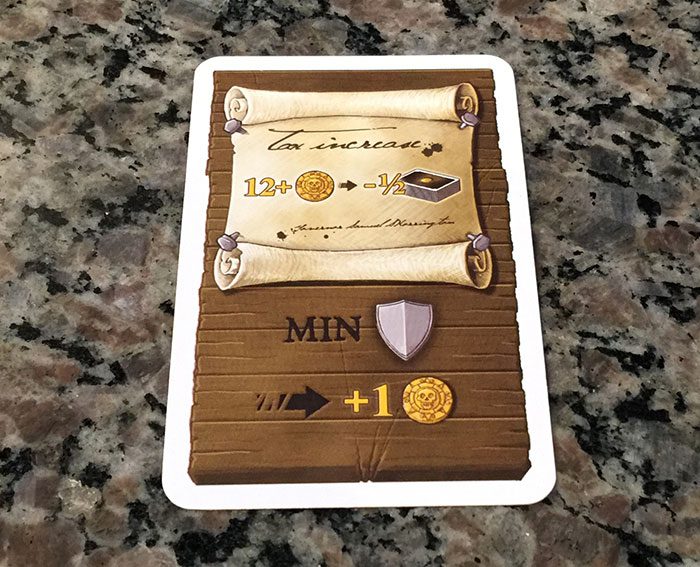
The Discover Phase
In the Discover phase the current player will draw cards from the top of the deck and place them into the Harbor. The player will continue to draw cards until either they choose to stop (at which time play proceeds to the Trade & Hire phase), or they are forced to stop.
If the active player draws two of the same color pirate ship play halts immediately and proceeds to the next player’s turn. In the below example the current player has drawn two yellow ships and must end their turn.
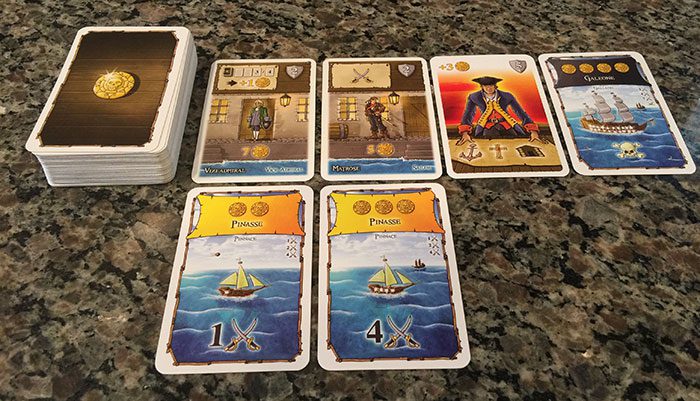
The Trade & Hire Phase
If the current player chooses to stop they will be able to select one or more cards from the Harbor to bring into their possession. If they select a ship, they take the amount of coins indicated on the ship and add it to their stack (making sure to include any modifiers). If they select one of the other types of cards, they will pay to hire that card. After they have selected all of their cards play proceeds around the table in clockwise fashion.
Each subsequent player will have the same 2 choices as the current player: taking a ship, or hiring a person. The difference is that each subsequent player must pay a single coin to the current player for the right to select a card. Play proceeds around the table until all players have had the chance to select a card from the Harbor. Discard any remaining cards. Current player status will then move clockwise to the next player and the play order begins again.
Play continues in this manner until one player has reached 12 victory points. At that time each player receives another “current player” turn and the game will end. The winner of the game is the one with the most victory points.
An official “end of game” variant requires players to have acquired at least one Expedition card.
What I Like About Port Royal
I like that Port Royal is lightweight, just a single deck of cards. That means it’s portable and easy to break out at any table. Although some turns you might wind up with a dozen or more cards on the table, in most cases it’s only 5 or 6. The Klemens Franz artwork is bright and colorful and the gameplay is wickedly deceptive.
Make no mistake, Port Royal starts off sort of slow, and because you’re learning the distribution of cards you’re going to bust…a lot. In my first few plays my game group and I sort of glanced around the table wondering if there really was a game here. But within 15-20 minutes we had gotten the hang of it and were racing towards the finish. Just make you give yourselves enough time to get a feel for the game.
I love love love games which feature multi-use cards. It’s such a challenge to pull off well. The cards themselves are the euro style thinner paper stock, but they’re well made and high quality. I personally prefer this paper because it’s easier to shuffle…and Port Royal has a LOT of cards to shuffle.
It seems that Alexander Pfister can do no wrong. Thus far I’ve played Isle of Skye, Oh My Goods, and Port Royal and have loved all of them. You might also be interested in my interview with Alexander Pfister.
What I Dislike About Port Royal
There’s only a few minor issues I have with Port Royal, and I expect that they’ll be largely resolved with the expansion I just picked up. Because it’s a pure victory point finish, it can feel like everyone is taking the same path. The expansion adds in contracts which require uses to complete certain tasks (similar to expedition cards). This gives Port Royal some variety and replay value.
There’s a LOT of cards. It can be tedious to shuffle this many cards.
Final Thoughts on Port Royal
If you’re a fan of press your luck style games, especially ones that are a cut above the rest, then Port Royal is for you. If you’re looking for a lightweight, portable card game that plays up to 5 then Port Royal is for you. Honestly if you like gaming, and you have a pulse, then Port Royal is for you. Pick it up and add it to your collection today!


